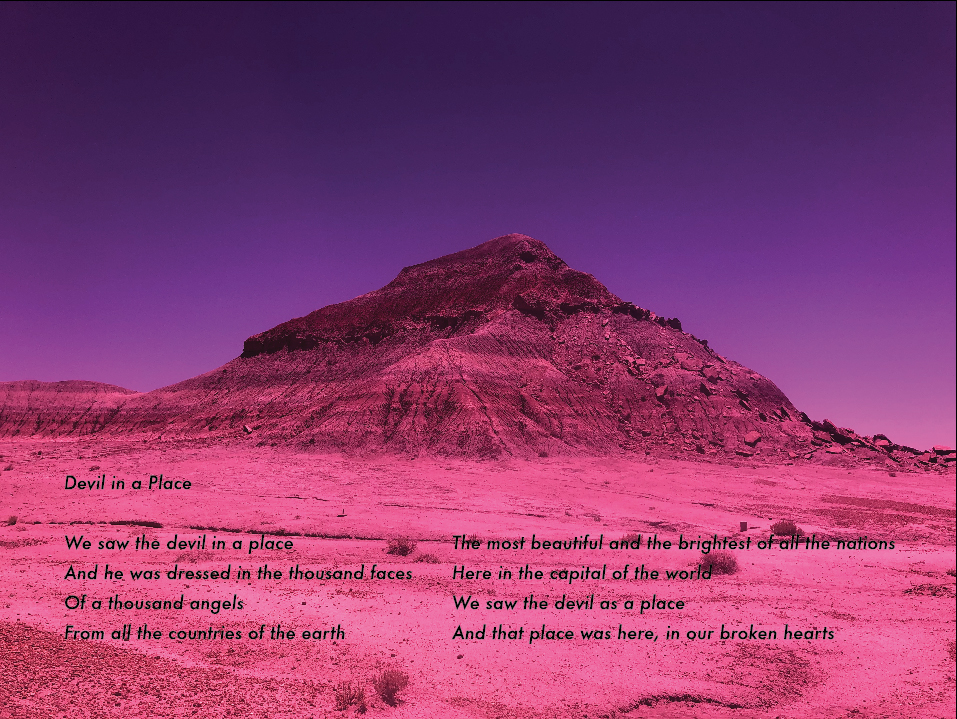


Samuel Levack and Jennifer Lewandowski, Devil In A Place, 2019. © Samuel Levack and Jennifer Lewandowski. 2019
“The desert he rode was red and red the dust he raised, the small dust that powdered the legs of the horse he rode, the horse he led. In the evening a wind came up and reddened all the sky before him. There were few cattle in that country because it was barren country indeed yet he came at evening upon a solitary bull rolling in the dust against the blood red sunset like an animal in sacrificial torment. The blood red dust blew down out of the sun. He touched the horse with his heels and rode on. He rode with the sun coppering his face and the red wind blowing out of the west across the evening land and the small desert birds chittering among the dry bracken and the horse and rider passed on and their long shadows passed in tandem like the shadow of a single being. Passed and paled into the darkening land, the world to come.” - Cormac McCarthy, All the pretty horses, 1992
Desert Ruins is an episodic, nomadic, road movie of a show. It reflects the contemporary reality of artists whose portmanteau careers encompass international residencies as well as the gigs that punctuate their musical project. And at the same time, there is a powerful, older narrative in play – one that speaks of traditions of journeying and peoples that construct identities and ways of life independent of prevailing narratives.
The show collates material gathered by Levack and Lewandowski over the last three years. The 2016 referendum here and later election of Donald Trump in the US are the monolithic events that cast long shadows over the narrative that takes in Glastonbury, Marseille, California and New Mexico. Unifying the landscape photographs of these disparate spaces is a colour cast, often red, that serves to distance the viewer and remove the images from the register of documentary. The diaristic form, particularly of the film projected in the back space of the gallery, allows for history recounted in real time. One section of the film invokes palm trees and planes coming in to land in LA skies, with campaigners holding up “Lock Her Up” placards to passing cars.
The US sections of the film are largely filmed from a moving car – the long sequences driving through forests where the sun slants through tall pines are stroboscopically mesmeric. They present a vision of an America that endures beyond the tides of politics. The film continually oscillates between pastoral and urban, utopian and dystopian.
For a decade now Levack and Lewandowski have been part of the crew that builds Glastonbury festival. Aside from the community that they have built around French Riviera on Bethnal Green Road, they are mainstays of this annually congregating community in Somerset. The utopian aspect of this is the pre-festival build moment, when making skills convene to create an ephemeral city from nothing; the dystopian is the euphoric aftermath, when the people are gone as suddenly as they came and what remains is like the scene after a battle.
Bringing together the ancient, lay-lined landscapes of Glastonbury with the storied deserts of the American southwest, the show tells a tale of determined individualism and of a connection to the land that supersedes political firestorms. Sequences in the Isle of Dogs, filmed from the gliding Docklands Light Railway, are hypnotic; this is work that offers no easy positions – it marvels instead at what is. Its glinting glass towers weirdly isolated in the middle of the city, the Isle of Dogs has a geography that predetermines a state of mind, for banker or mudlark alike.
Sam Levack’s texts float over the photographs and he, Jennifer Lewandowski and Ellen Mara de Wachter’s voices provide a contemplative, highly personal commentary – traveler’s impressions – over the film. The result is work deeply rooted in its turbulent time, revealing individuals reaching towards ways of living and working.
French Riviera is a diminutive, artist-run operation. It endures as an outpost of independent thinking while gentrification marches apace up Bethnal Green Road from the city. It is relatively unusual for Levack and Lewandowski to show their own work, so Desert Ruins is an important opportunity to see the product of the last three turbulent years.
Caroline Douglas
Director
French Riviera, 309 Bethnal Green Road, London E2 6AH. Open Friday – Sunday, 12.00–18.00 & by appointment. Exhibition continues until 20 October 2019. www.frenchriviera1988.com